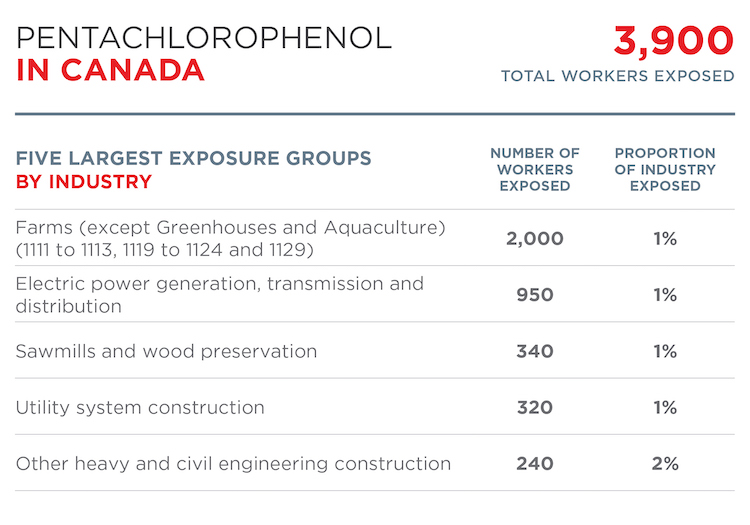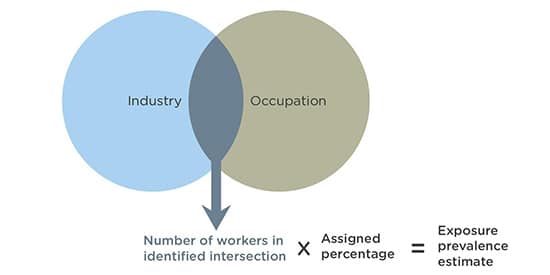Pentachlorophenol Occupational Exposures
Pentachlorophenol Occupational Exposures
Overview
Occupational exposure to pentachlorophenol occurs via dermal contact with the compound while treating wood products, or by inhaling contaminated workplace air (i.e. during production or use of PCP).[1,2] One study found that dermal contact accounted for 95% of total worker exposure in sawmills.[3]
CAREX Canada estimates that approximately 3,900 Canadians are exposed to PCP in their workplaces. The largest industrial groups exposed are farms, electrical power generation (transmission and distribution), and sawmills and wood preservation. The largest occupational groups exposed to pentachlorophenol are electrical power line and cable workers, managers in agriculture, general farm workers, and agriculture service contractors, farm supervisors, and specialized livestock workers.
Prevalence Estimate
Results show that approximately 3,900 Canadians are occupationally exposed to pentachlorophenol (PCP); 83% of these workers are male. The largest industrial groups exposed are farms (where PCP is encountered via the handling of fence posts), electrical power generation (transmission and distribution), and sawmills and wood preservation.
The largest occupational groups exposed to pentachlorophenol are electrical power line and cable workers (1,000 workers exposed), managers in agriculture (720 workers exposed), general farm workers (710 workers exposed), and agriculture service contractors, farm supervisors, and specialized livestock workers (560 workers exposed).
The number of workers exposed to pentachlorophenol decreased by approximately 380 workers from 2006 to 2016 (a 9% decrease). This was driven by a decrease in the total number of workers in the farm and sawmill industries.
Workers exposed to pentachlorophenol by industry in 2016

Workers exposed to pentachlorophenol by region in 2016
Click the second tab to view total number of workers exposed.
* = < 50 workers
Methods and Data
Our Occupational Approach page outlines the general approach used to calculate prevalence and exposure level estimates for workplace exposures.
Data Sources
Data used in developing the occupational estimates for pentachlorophenol (PCP) were collected from several sources:
- The Canadian Workplace Exposure Database (CWED) contains approximately 500 measurements for PCP exposure. These measurements were collected during the years 1981 to 2004 in Ontario and British Columbia workplaces.
- Canadian and US scientific peer reviewed publications that addressed PCP exposure in Canada and the United States.
- Grey literature including technical reports from governments and international bodies.
Prevalence Estimate Method
CAREX defines exposure to PCP as inhalation or dermal exposure at work to levels likely to exceed non-occupational exposure.
To determine the number of workers potentially exposed to PCP at work, CAREX occupational exposure experts used methods previously established in other peer-reviewed CAREX projects in Europe. A series of steps were taken to assign exposure proportions to occupations and industries at risk of exposure to PCP.

- Occupations and industries at risk of possible exposure to PCP were identified using any combination of data sources described above.
- The total number of workers in each identified occupation and industry intersection was obtained from Statistics Canada 2016 census data.
- A percentage of workers exposed was assigned to that occupation and industry intersection. Percentages were determined by consultation with existing evidence in the data sources, previously established methods from the Europe CAREX estimates and the expert judgement of CAREX occupational hygienists.
- The number of workers in the identified group is multiplied by the assigned percentage to calculate the prevalence estimate of workers exposed to PCP.
Sources
Subscribe to our newsletters
The CAREX Canada team offers two regular newsletters: the biannual e-Bulletin summarizing information on upcoming webinars, new publications, and updates to estimates and tools; and the monthly Carcinogens in the News, a digest of media articles, government reports, and academic literature related to the carcinogens we’ve classified as important for surveillance in Canada. Sign up for one or both of these newsletters below.
CAREX Canada
School of Population and Public Health
University of British Columbia
Vancouver Campus
370A - 2206 East Mall
Vancouver, BC V6T 1Z3
CANADA
As a national organization, our work extends across borders into many Indigenous lands throughout Canada. We gratefully acknowledge that our host institution, the University of British Columbia Point Grey campus, is located on the traditional, ancestral, and unceded territories of the xʷməθkʷəy̓əm (Musqueam) people.



